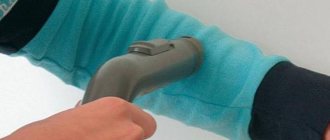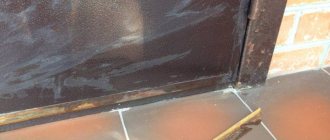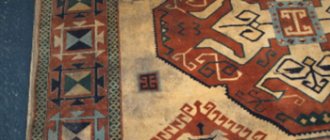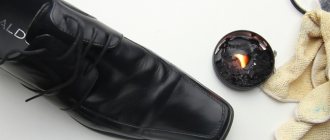Removing grease stains from any type of fabric is not entirely easy. You can use dry cleaning services, but sometimes this is not possible. There are a number of acceptable ways to help remove unpleasant traces of fat yourself at home.
Stains on silk must be removed with extreme care
Easier to deal with stains caused by vegetable oils, butter and lard. It is more difficult to remove traces of oil paint, varnish or resin. The result depends on the type of fabric and the age of contamination.
Baby powder
For thin and delicate fabrics, products are used that preserve their structure and appearance. If clothes made of silk fabric are contaminated with grease, then using baby powder is effective. It is usually used for babies to remove excess moisture from their delicate skin. In the same way, it helps remove fat. Even subsequent washing is not necessary. The powder has a very fine structure. It easily penetrates the fabric, which even the finest salt is not capable of. To remove fat from silk, sprinkle the stain with powder and leave for a quarter of an hour. This method is universal; it can be used to remove dirt from any fabric.
Baby powder is suitable for removing stains from any fabric
What you need to know when washing silk
There are several rules to remember when cleaning stains from silk. Nothing impossible, just simple measures to prevent disasters when washing:
- Check color fastness
. Some fabric dyes come off easily when washed. You can easily check the fastness of the paint by blotting the inside of the item with a clean, damp cloth (preferably white). If even a little color transfers from the clothing to the fabric, we recommend that you take it to a dry cleaner.
- Avoid heat
. No hot water washing, no irons, no dryers. Silk loves the cold.
- Wash with a mild detergent
. Delicate fabrics require delicate care. Take a special product for silk and wool.
- Don't use bleach.
Strong chemicals such as bleaches are likely to damage the natural fibers of silk.
- Check the label.
Some silk items are machine washable, some need to be hand washed, and some are dry clean only - take these items to the professionals.
Now you can start washing.
Starch
Starch is a good helper in the fight against traces of fat on thin fabrics. It doesn't matter whether it's potato or corn. Every housewife has starch, while young parents most often have powder. After cleaning the fabric, it becomes starched. Repeated rinsing in clean, cool water will help get rid of it. If the stain cannot be removed, the procedure should be repeated. Instead of starch, you can use mustard powder. This method is used to remove old traces of fat:
- take 2 tbsp. l. potato starch;
- add water until you get the consistency of sour cream;
- the mixture should be heated and applied to the stain;
- stand for 1 hour;
- wash by adding stain remover. It can be replaced with laundry soap.
Sprinkle starch on the fabric until the stain disappears
Chemicals for removing traces of grease
Among the chemical agents for fighting stains that have proven themselves best:
- SA8 stain pre-removal spray from Amway;
- Vanish Oxi Action liquid stain remover for delicate fabrics;
- Ace Oxi magic;
- Udalix Oxi Ultra;
- cover remover;
- Sarma Active;
- Antipyatin. The product is available in the form of soap, powder or spray;
- Astonish Oxi Plus;
- Laundry baby soap Eared nannies with whitening effect;
- Faberlic, Edelstar universal stain remover pencil.
Some of them must be added to the water when washing, others are used to pre-treat the soiled surface. The quality of a product often does not depend on its cost. Therefore, you should not rely on price as a guarantee of high quality stain remover.
An important role in achieving the result is played by the device used to apply the stain removal composition.
Best suited for this role:
- soft brush;
- fresh disposable cloth;
- cotton pad;
- clean brush;
- cotton swab.
The softer the chosen tool, the less likely it is to ruin the delicate fabric.
Silk products require frequent ventilation and drying. They are afraid of direct sunlight and high humidity.
Ammonia and glycerin
Ammonia will help remove greasy stains from silk products. Although it has an unpleasant odor, it is a good helper. Do not use it undiluted. It should be remembered that it burns the skin and can damage the respiratory tract. Therefore, all procedures are carried out in a room with good ventilation. Hands should be protected with gloves. Mode of application:
- take a tablespoon of ammonia;
- add 3 tbsp. cool water;
- add half a tablespoon of salt;
- mix everything and apply the resulting mixture to a greasy area;
- stand for a quarter of an hour;
- wash according to recommendations and rinse.
You can use a more gentle method of cleaning silk. To do this, prepare a solution using glycerin:
- take two tablespoons of water and glycerin;
- you need to add 1 tbsp. ammonia;
- place the contaminated product in the resulting solution for half an hour;
- perform normal washing.
Ammonia and glycerin need to be dissolved in water and the silk item should be soaked in it.
How to remove stains from silk
If you find a greasy stain on silk clothes, you can use one of the following methods:
- Act as soon as possible - dried stains are much harder to remove;
- Gently blot the stained area with a clean cotton swab or paper towel to remove as much dirt as possible from the fabric;
- Make a cleaning solution from a few tablespoons of lemon juice or white vinegar and the same amount of cool water;
- Before using the solution, test it on a small, inconspicuous piece of silk;
- Gently apply the solution to the stained area with a clean white cloth. Don't rub it in;
- Wash your silk item as usual, following the instructions on the label.
If the greasy stain is also staining - for example, left by a piece of stew or other food that fell on clothing - then you will need to use a different method. As with most contaminants, you need to act quickly. But the methodology is the same:
- Gently scrape off excess oil or grease;
- Sprinkle the stain generously with talcum powder and let it soak in the grease for several hours, or leave overnight;
- Carefully remove the powder from the fabric with a brush and wash the item as usual.
- Talc can be replaced with baby powder based on it.
Laundry soap
A universal remedy in the fight against fresh stains of any origin is laundry soap. It cleans the finest fabrics well, such as chiffon, silk or organza. The fat content of soap should not be less than 70%. Mode of application:
- fatty areas should be washed with soap;
- wrap the product in cellophane;
- stand for 12 hours;
- carry out normal washing;
- rinse in plenty of water.
We can also use this method:
- lather the stain with soap;
- sprinkle a tablespoon of sugar on top;
- leave the product for a quarter of an hour;
- perform washing and rinsing.
Laundry soap will not harm silk
Ways to remove stains from silk
There are many time-tested folk remedies that allow you to carefully and efficiently remove stains from silk without damaging the material. You must first determine the type of contamination in order to choose the right method to eliminate it.
The most popular stains are:
- Traces of sweat . To remove them, medical alcohol is usually used. A cotton swab is thoroughly moistened with it, and then applied to the stain by touch. If the result was not achieved the first time, the procedure is performed again after the material has dried.
- Yellow spots on white silk . Wash clothes thoroughly in water and vinegar and then dry them in the shade in a ventilated place.
- Perfume stains . To remove them, a cotton swab is dipped in technical ethyl alcohol, and then the liquid is carefully applied to the stain.
- Traces of alcohol, coffee and tea . A thin layer of glycerin is applied to clothing for 30 minutes. Next, rinse it off with cool water, and then wash the item together with silk detergent.
- To remove blood stains , apply a thick paste of potato starch to them, and after the product dries, shake it off and wash the item in any acceptable way.
- Ink . The marks are treated with turpentine, left for a short time, and then washed with cloth. It is also possible to use a product made from mustard powder. It will also allow you to remove greasy stains from silk products.
- To remove traces of fat , it is recommended to use baby powder. Thanks to its fine structure, it penetrates deeply into the material. Sprinkle the product onto the stain and shake it off after twenty minutes. Usually, washing is not even required after the procedure.
- traces of decorative cosmetics on things , they can be removed by washing, following all the recommendations for caring for silk.
- You can remove greasy stains from personal care products on silk underwear or bedding with a mixture of ammonia and technical ethyl alcohol.
- If oil traces from lipstick , they are treated from the inside of the fabric with medical alcohol, after placing a white cloth with high absorbent properties or a plain paper towel on the outside.
- Stains from juice and berries can be effectively removed with such means as a 10% solution of vinegar or vodka mixed in equal parts with glycerin.
- remove grass stains from silk items at home by mixing peroxide with ammonia.
- red wine was carelessly spilled on silk items , you should immediately sprinkle it with regular kitchen salt, and then wait a while and shake it off.
- To remove traces of champagne or white wine , they are first treated with glycerin, and then the item is thoroughly washed, following the recommendations for caring for the material.
- Stains on artificial silk clothes can be removed with vinegar, lemon, oxalic acid, acetone, and hydrogen peroxide. The product is first tested on an inconspicuous area to make sure that it will not damage the fabric.
It is important to understand that getting rid of new stains is much easier than getting rid of old ones, and in this case a positive result is more likely.
A universal remedy for any stains is laundry soap.
It is carefully applied to the material, then the item is wrapped in cellophane, left for 12 hours, after which it is washed and rinsed in a large volume of water. There is another way: soap the dirt and add a tablespoon of sugar on top. The product is left for 20 minutes, after which the product is washed.
Chalk in its pure form also allows you to remove greasy stains. They sprinkle it on the marks, leave it for 3 hours, then wash the item. Another solution is to mix chalk with talcum powder, apply the product to the dirt outside and inside, cover with white paper, place a heavy object on top and leave for a day. After 24 hours, shake off the product.
Gasoline can remove any traces, but first you need to check how it will affect the silk. To do this, the substance is applied to a small area of the product. If it has not changed its structure and color, this means that the stain can be removed. To do this, moisten a clean cloth with gasoline and place it under the dirt from the inside out. Next, use a cotton swab dipped in liquid to treat the mark from the edge to the center so that it does not increase. After the procedure, the product must be washed thoroughly.
For oily spots, you can use shampoo for oily hair. It is applied to the marks for an hour, and then the item is washed. Another solution is blotting paper folded in several layers. It is applied to the stain on both sides, ironed, after which the clothes are washed.
If old traces of sweat are found on items made of natural silk, in order to remove them, you will need to soak the clothes in heated water with dissolved soda for a long time. Next, the products need to be rinsed in water, adding a small amount of vinegar to it.
First aid
Regardless of how the clothes were stained, you need to start cleaning as early as possible. Fresh stains are easy to remove the first time, but in the fight against old ones, more than one treatment of the material may be necessary.
- As soon as you see that you have stained your clothes, take them off and treat the area around the grease stain with water or talcum powder so that the stain does not grow. You can’t wash the entire thing at once, as you won’t be able to get rid of the stain.
- Wear gloves.
- Find a hard piece of wood and wrap it in a clean cloth.
- Place the soiled clothing on it and start treating the stain from the edges to the center. If you do the opposite, it may increase in size.
- Use cotton swabs or pads.
So, the basis of success is compliance with two basic rules:
- mandatory treatment of the contaminated area before washing the entire product;
- processing must begin immediately.
Where do grease stains come from?
Human skin constantly secretes a substance that consists of lipids, salt and water. This is why yellow stains appear on collars and cuffs that are difficult to wash off. They are especially noticeable on light cotton fabric: blouses, shirts, underwear.
Typical stains appear on clothes during the process of preparing and eating food or during any technical work.
Fat comes from different origins:
- vegetable: various oils obtained from fruits, seeds, grains, seeds;
- animal: lard, cream, loy;
- synthetic: emulsions and pastes for lubricating rubbing parts.
Therefore, the chemical composition of the pollutant is significantly different, therefore, it must be removed in different ways.
What you really shouldn't do is put the item you've put a greasy stain on into the washing machine. The greasy area must first be treated, otherwise surfactants under the influence of temperature will help the fat penetrate deep into the fibers, making it impossible to remove it.
How to remove old grease stains at home
Grease stains on clothes bring discomfort, as they are very noticeable and greatly spoil the appearance. The most difficult stains to remove are those that appeared a long time ago and have had time to be well absorbed into the fabric. To remove them, it is necessary to use more effective means that can dissolve even such contaminants.
Preventing stains on silk
For fabrics such as dupont, crepe de chine, colored silk, only dry cleaning is recommended.
If the care instructions allow hand washing, the item can be washed in cool water with a small amount of delicates gel. The detergent must not contain alkali. To prevent things from becoming electrified when worn, an antistatic agent or softener must be added to the water. This fabric should not be soaked. To maintain the brightness of the colors, you need to rinse the product in water with the addition of a few tablespoons of vinegar and rinse again in clean water.
If the instructions do not prohibit washing in a machine, the fabric should be packed in a net, use the most delicate mode and a temperature of less than 30 °C. It is better to refuse spinning. The washed item of clothing is hung on hangers to dry it, or laid out on a dry, clean terry towel.
Silk clothes are ironed slightly under-dried, turned to the left. The iron is turned on to the lowest temperature without steam.
If yellow splashes appear on clothes, they are removed by rinsing in water with the addition of vinegar essence. A couple of teaspoons of hydrogen peroxide or ammonia added during washing will return white silk to its original purity.
Any hair cosmetics, be it varnishes or foams, must be applied before putting on a silk item. Any drop of household chemicals can be detrimental to the material.
It is best to wear an outfit made of this noble and capricious fabric in those places where the possibility of staining it with fat is reduced to zero.
Sources and types of pollution
- Animal and vegetable fat in its pure form (oil, fat) forms a dark stain, then is absorbed into the structure of the fibers of the fabric and brightens, leaving a vague outline and a matte color stain.
- Bold spots. These are water-fat solutions (meat broth, soup), which instantly saturate the fabric through and through, leaving a clear mark. These are also any products that contain fat: milk, sauce, soup, ice cream. These also include cosmetics. It can be quite difficult to remove stains from lipstick, powder, foundation, hand and face cream, and perfume. They form a dark stain that, if not treated immediately, will soak in and lighten.
- Technical oils and liquids, such as grease, diesel fuel, gasoline and others, leave dark or light-colored traces that are difficult to remove. This also includes oil paint for painting, stain removal from which is also complicated by the presence of a coloring pigment.
Useful
When trying to remove such stains, it is important to remember that not all types of fabrics can withstand the effects of acids, alcohols, and alkalis. For example, viscose or acetate silk cannot be treated with vinegar and acetone, and the acid can discolor the dyed fabric.











